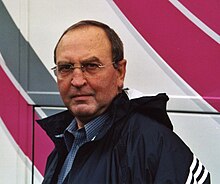 Godefroot in 1997 | |||||||||||||||
| Personal information | |||||||||||||||
|---|---|---|---|---|---|---|---|---|---|---|---|---|---|---|---|
| Full name | Walter Godefroot | ||||||||||||||
| Nickname | The Bulldog of Flanders | ||||||||||||||
| Born | 2 July 1943 Ghent, Belgium | ||||||||||||||
| Team information | |||||||||||||||
| Discipline | Road | ||||||||||||||
| Role | Manager | ||||||||||||||
| Rider type | One-day specialist | ||||||||||||||
| Professional teams | |||||||||||||||
| 1965–1966 | Wiel's–Groene Leeuw | ||||||||||||||
| 1967–1969 | Flandria–De Clerck | ||||||||||||||
| 1970 | Salvarani | ||||||||||||||
| 1971–1972 | Peugeot–BP–Michelin | ||||||||||||||
| 1973–1975 | Flandria–Carpenter–Shimano | ||||||||||||||
| 1976–1979 | IJsboerke–Colnago | ||||||||||||||
| Managerial teams | |||||||||||||||
| 1991–2005 | Team Telekom | ||||||||||||||
| 2006 | Astana–Würth | ||||||||||||||
| 2007 | Astana | ||||||||||||||
| Major wins | |||||||||||||||
Grand Tours
| |||||||||||||||
Medal record
| |||||||||||||||
Walter Godefroot (born 2 July 1943) is a retired Belgian professional road bicycle racer and former directeur sportif of Team Telekom, later known as T-Mobile Team.
As amateur cyclist, he won the bronze medal in the individual road race of the 1964 Summer Olympics after his young compatriot Eddy Merckx was caught in the final.[1] Both men turned professional in 1965 and Walter Godefroot was presented as Merckx's bane in his early days, winning several races ahead of him: the Belgian championship in 1965, Liège–Bastogne–Liège (1967) and Paris–Roubaix (1969).[2]
But Godefroot eventually didn't have Merckx's abilities in stage races and concentrated on the separate stages in the grand tours. He won ten stages in the Tour de France, including the stage on the Champs-Élysées in 1975 where the Tour finished for the first time, and the green jersey in the 1970 Tour de France, one stage in the 1970 Giro d'Italia and two stages in the 1971 Vuelta a España.[3]
Being a specialist in one-day classic cycle races, he won another Belgian champion title in 1972, two Tours of Flanders at ten-year intervals in 1968 and 1978, two Bordeaux–Paris in 1969 and 1976 and had numerous runner-ups in other classics.
Remarkably, Godefroot informed the Tour de Flandres organization about the existence of the Koppenberg. From 1976, the hill was included in the course of the race.
At the end of his career, following the classics campaign in April 1977, he tested positive for a doping product along with several other top riders.
In 1981, Godefroot and his wife started a cycling shop in Deurle which still exists today.[4]
He managed the Capri-Sonne-Koga Miyata, T-Mobile and Astana teams. He was notably the sports director of Bjarne Riis, Jan Ullrich and Erik Zabel during the victorious Tour de France editions in 1996 and 1997, although Riis and Zabel later admitted they used EPO in the 1996 Tour de France.[5]
Godefroot stepped down as team manager before the 2006 season and was replaced by Olaf Ludwig. After the exclusion of Astana–Würth from the 2006 Tour de France, Godefroot returned to the peloton when he became manager of Astana. His contract was not renewed when it ran out in July 2007.[6] He then withdrew from professional cycling.
In his racing days he was called 'The Bulldog of Flanders'.
- ^ "Walter Godefroot Olympic Results". sports-reference.com. Archived from the original on 18 April 2020. Retrieved 18 August 2014.
- ^ "Godefroot: "Mijn leven is mooi geweest, maar de zon heeft niet altijd geschenen"" (in Dutch). 18 June 2017.
- ^ "Walter Godefroot". dewielersite.be. Retrieved 16 May 2003.
- ^ "Fietsen Godefroot" (in Dutch).
- ^ "Former Tour de France winner Riis admits doping". 25 May 2007. Retrieved 26 May 2007.
- ^ "Astana und Godefroot gehen getrennte Wege". Der Spiegel (in German). Sport-Informations-Dienst. 2 July 2007. Retrieved 16 May 2020.